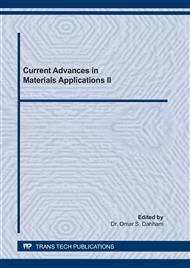[1]
O.K. Abiola, Y. Tobun, Cocos nucifera L. water as green corrosion inhibitor for acid corrosion of aluminium in HCl solution, Chin. Chem. Lett. 21 (2010) 1449–1452.
DOI: 10.1016/j.cclet.2010.07.008
Google Scholar
[2]
N.R. Rosli, S.M. Yusuf, A. Sauki, W.M. Razlan, W. Razali, M. Sapientum (Banana) Peels as Green Corrosion Inhibitor for Mild Steel, Key Engineering Materials, Vol. 797, (2019), 230-239.
DOI: 10.4028/www.scientific.net/kem.797.230
Google Scholar
[3]
Sh. A. Abdulsada, É. Fazakas, T. Török, Corrosion testing on steel reinforced XD3 concrete samples prepared with a green inhibitor and two different super plasticizers, Materials and Corrosion, (2019), 1-11.
DOI: 10.1002/maco.201810695
Google Scholar
[4]
M. Mobin, M. Rizvi, L. Olasunkanmi, and E. Ebenso, Biopolymer from Tragacanth Gum as a Green Corrosion Inhibitor for Carbon Steel in 1 M HCl Solution, American Chemical Society, ACS Omega, 2, (2017), 3997−4008.
DOI: 10.1021/acsomega.7b00436
Google Scholar
[5]
M. Rana, S. Joshi and J. Bhattarai, Extract of Different Plants of Nepalese Origin as Green Corrosion Inhibitor for Mild Steel in 0.5 M NaCl Solution, Asian j. of Chem. Vol. 29, No. 5 (2017), 1130-1134.
DOI: 10.14233/ajchem.2017.20449
Google Scholar
[6]
A. Peter1, I.B. Obot, S.K. Sharma, Use of natural gums as green corrosion inhibitors: an overview, Int. J. Ind. Chem., (2015). DOI 10.1007/s40090-015-0040-1.
Google Scholar
[7]
P. Singh, S.S. Chauhan, G. Singh, M. A. Quraishi. Corrosion Inhibition by Green Synthesized Inhibitor: 4,4-(1,4Phenylene) bis (6-amino-3-methyl-2,4dihydropyrano [2,3-c]pyrazole-5 arbonitrile) for Mild Steel in 0.5 M H2SO4,Solution, Journal of Bio- and Tribo-Corrosion, J. of Bio- and Tribo-Cor., 5:11 (2019) 2-9.
DOI: 10.1007/s40735-018-0204-6
Google Scholar
[8]
N.A. Odewunmi, S.A. Umoren, Z.M. Gasem, Watermelon waste products as green corrosion inhibitors for mild steel in HCl solution, J. of Env. Chem. Eng., Vol. 3, No.1, (2015) 286-296.
DOI: 10.1016/j.jece.2014.10.014
Google Scholar
[9]
B. Davo´, A. Conde, J.J. de. Damborenea, Inhibition of stress corrosion crackingof alloy AA8090 T-8171 by addition of rare earth salts, Corr. Sci. j. 47 (2005) 1227–1237.
DOI: 10.1016/j.corsci.2004.07.028
Google Scholar
[10]
F.S. de Souza, A. Spinelli, Caffeic acid as a green corrosion inhibitor for mild steel, Corr. Sci. j. 51 (2009) 642–649.
DOI: 10.1016/j.corsci.2008.12.013
Google Scholar
[11]
H.N. Soliman, Influence of 8-hydroxyquinoline addition on the corrosion behavior of commercial Al and Al-HO411 alloys in NaOH aqueous media, Corr. Sci. j. 53 (2011) 2994–3006.
DOI: 10.1016/j.corsci.2011.05.045
Google Scholar
[12]
A.Y. El-Etre, Inhibition of aluminum corrosion using Opuntia extract, Corr. Sci. 45 (2003) 2485–2495.
DOI: 10.1016/s0010-938x(03)00066-0
Google Scholar
[13]
S. Banerjee, V. Srivastava, M.M. Singh, Chemically modified atural polysaccharide as green corrosion inhibitor for mild steel in acidic medium, Corrosion Science 59 (2012) 35–41.
DOI: 10.1016/j.corsci.2012.02.009
Google Scholar
[14]
N. Vaszilcsina, V. Ordodib, Al. Borzaa, Corrosion inhibitors from expired drugs, Int. J. of Pharm. 431 (2012) 241– 244.
Google Scholar
[15]
A.Y. El-Etre, Inhibition of aluminum corrosion using Opuntia extract, Corros. Sci. 45, 11 (2003) 2485–2495.
DOI: 10.1016/s0010-938x(03)00066-0
Google Scholar
[16]
Y. Ren, Y. Luo, K. Zhang, G. Zhu, X. Tan, Lignin Terpolymer for Corrosion Inhibition of Mild Steel 10 10% hydrochloric acid medium, Corr. Sci. 50, 11, (2008) 3147–3153.
DOI: 10.1016/j.corsci.2008.08.019
Google Scholar
[17]
O.K. Abiola, A.O. James. The effects of Aloe vera extract on corrosion and kinetics of corrosion process of zinc in HCl solution, Corr. Sci. 52 (2010) 661–664.
DOI: 10.1016/j.corsci.2009.10.026
Google Scholar
[18]
M.M. Fares, A.K. Maaytaa, M.M. Al-Qudah, Pectin as promising green corrosion inhibitor of aluminum in hydrochloricacid solution, Corr. Science 60 (2012), 112–117.
DOI: 10.1016/j.corsci.2012.04.002
Google Scholar
[19]
M. Belloa, N. Ochoaa, V. Balsamoa, F.L. Carrasquerob, S. Coll, A. Monsalved, Gema Gonzez," Modified cassava starches as corrosion inhibitors of carbon steel: An electrochemical and morphological approach, Carbohydrate Polymers 82 (2010) 561–568.
DOI: 10.1016/j.carbpol.2010.05.019
Google Scholar
[20]
S.A. Kumar, Dr. A. Sankar, S. Rameshkumar, Corrosion Inhibition of mild steel in Acid Media by Alpina galinga Extract, Journal of Applied Chemistry (IOSR-JAC), 4,1 (2013) 61-64.
DOI: 10.9790/5736-0416164
Google Scholar
[21]
S.A. Ajeel, Green Corrosion Inhibitor for Protection of Mild Steel, Eng. and Tech. J., Vol. 35, (2017) Part A, No. 9.
Google Scholar
[22]
M. Bouanisa, M. Tourabia, A. Nyassia, A. Zarroukb, C. Jamac, F. Bentissa,c, Corrosion inhibition performance of 2,5-bis(4-dimethylaminophenyl)-1,3,4-oxadiazole for carbon steel in HCl solution: Gravimetric, electrochemical and XPS studies, Appl. Surf. Sci. 389 (2016) 952–966.
DOI: 10.1016/j.apsusc.2016.07.115
Google Scholar
[23]
Ch. B.P, and P. Rao, Starch as an ecofriendly green inhibitor for corrosion control of 6061-Al alloy, J. Mater. Environ. Sci. 8 (1) (2017) 78-89.
Google Scholar
[24]
M.V. Fiori-Bimbi, P.E. Alvarez, H. Vacaa, C. A. Gervasi, Corrosion Inhibition of Mild Steel in HCl Solution by Pectin, Corrosion Science. 92 (2015) 192-199.
DOI: 10.1016/j.corsci.2014.12.002
Google Scholar


